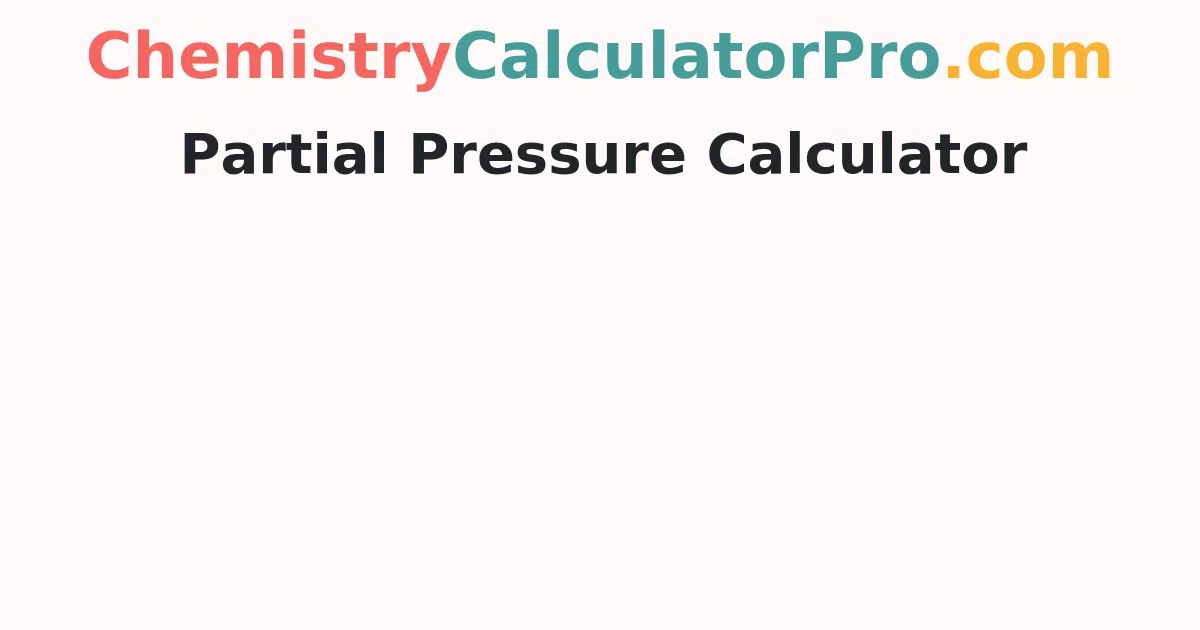Partial Pressure Calculator
The Partial Pressure Calculator is a simple tool for calculating and understanding the partial pressure of gases. The partial pressures are calculated using Henry's Law, Ideal Gas Law, and Dalton's Law. To quickly check the outcome, simply enter the relevant information and press the calculate button.
Dalton's Law
Ideal Gas Law
Henry Law Method 2
Henry Law Method 1
Dalton's Partial Pressures Law
Pressure is the force that is applied orthogonally over a surface. If you fill a container with a perfect gas mixture (molecules that don't interact), the gases will disperse and take up all of the available space. Partial pressure is the pressure exerted by one component of this mixture.
According to Dalton's law: A gas mixture's total pressure on a container's walls is equal to the sum of the partial pressures of each individual gas. An equation can also be used to illustrate it Total Pressure = p1 + p2 +... + pn. The partial pressures of each gaseous component are represented by p1, p2, and so on, up to pn. partial pressure = total pressure * mole fraction
The mole fraction is the ratio of the selected gas's moles to the total gas mixture's moles. It demonstrates that a component's partial pressure is proportional to its mole fraction.
Partial Pressure using Ideal Gas Law
According to the ideal gas law equation: p * V = n * R * T
- Where, p = pressure of the gas
- V = volume of the gas
- n = number of moles of the gas
- R = gas constant, 8.3145 J/mol*K
- T = temperature of the gas
Use the following formula (derived from the one above) to compute the partial pressure of one component of a gas mixture: pi = (ni * R * T) / v
- Where, pi = partial pressure of the individual gas
- ni = number of moles of the individual gas
- T = temperature of the mixture
- V = volume of the mixture
Calculating Partial Pressure Using Henry's Law
According to Henry's law, The partial pressure of a gas above a liquid is proportional to the amount of gas dissolved in the liquid. Henry's constant is the proportionality coefficient. When we have a concentration of the solute, we employ Henry's law method 1. Pressure = KH1 x concentration
When the mole fraction of the solute is known, Method 2 is utilised. Pressure = KH2 x mole fraction, Where, Henry's law constant (litre x atm/mol) is KH1. Henry's law constant in the atm is KH2.
| Element | Henry's law constant [litre*atm/mol] | Henry's law constant [atm] |
|---|---|---|
| O2 | 769.23 | 4.259*104 |
| H2 | 1282.05 | 7.099*104 |
| Co2 | 29.41 | 0.163*104 |
| N2 | 1639.34 | 9.077*104 |
| He | 2702.7 | 14.97*104 |
| Ne | 2222.22 | 12.3*104 |
| Ar | 714.28 | 3.955*104 |
| CO | 1052.63 | 5.828*104 |
How to Determine Partial Pressure?
The steps to easily calculate the partial pressure of gases are as follows. Take a look at them and pay more attention to what they say.
Dalton's Law:
- Step 1: From the question, determine the total pressure and mole fraction.
- Step 2: To determine the partial pressure, multiply the total pressure by the mole fraction.
Ideal Gas Law:
- Step 1: The number of moles, the temperature, and the volume should all be known.
- Step 2: Combine the number of moles, the temperature, and the universal gas constant.
- Step 3: To obtain the partial pressure of ideal gases, divide the product by the volume of the gas.
Henry Law:
- Step 1: Find the name of the gas as well as the mole fraction or concentration.
- Step 2: Multiply the concentration by the Henry law constant.
- Step 3: Alternatively, multiply the mole fraction by the constant.
How to use the Partial Pressure Calculator?
The following is the procedure how to use the partial pressure calculator
- Step 1: In the input field, enter the mole fraction of the solution and the Henry constant for the mole fraction.
- Step 2: To receive the result, click the "Calculate Partial Pressure" button.
- Step 3: In the output field, the partial pressure calculated using the mole fraction of the solute will be presented.
FAQ’s on Partial Pressure
1. What is the procedure for calculating partial pressure?
Ptotal=P1+P2+... +Pn. + Pn. The total pressure of a mixture of gases can be described as the sum of the individual gas pressures: The partial pressure of a single gas is equal to the total pressure multiplied by the gas's mole fraction.
2. With partial pressure, how do you find K?
Subtract the partial pressure of H2 from the overall pressure to get the partial pressure for H2O. Then, in terms of activities, write K (equilibrium constant expression). Solids and pure liquids are not taken into account.
3. How do you find partial pressure from moles?
The ideal gas equation may be adjusted to show that the pressure of a sample of gas is directly proportional to the number of moles of the gas present if volume and temperature are kept constant: P=n(RTV)=n×const.
